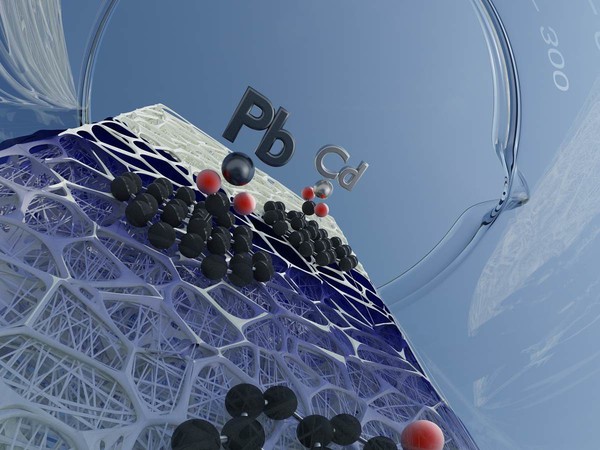A cheap, efficient, and recyclable nanomaterial that can not only detect but also remove heavy metals from water—this is an outstanding result of collaboration between scientists from the Czech Advanced Technology and Research Institute (CATRIN) of Palacký University Olomouc, VSB-TUO, and the Catalan Institute of Nanoscience and Nanotechnology (ICN2) in Barcelona. The researchers used so-called graphene dots derived from the Nobel material graphene for the preparation of a paper detector. A simple test will prove the presence of dangerous heavy metals, especially cadmium and lead, without costly devices in about 30 minutes..
The contamination of wastewater by industrial activities is a burning problem today, with lead and cadmium, alongside mercury, being among the most toxic heavy metals. Their release into the environment causes extensive damage to the aqueous ecosystem and contamination of agricultural crops. In humans, the long-term exposure to these heavy metals may lead to serious failure of organs and vital functions; their carcinogenic effects have also been proven.
“It is very important to have a cheap technology that can detect these highly harmful substances in water even in small amounts and, at the same time, eliminate them effectively. The newly developed material can do both—in the form of a paper sensor it reliably identifies cadmium or lead and then in the form of nanoparticles it removes these metals with record efficiency. This is the direction that modern technologies are now taking. A similar process is being followed in medicine, for example, when one substance, administered to a human body, diagnoses a disease and subsequently treats it,” said one of the authors of the research, Radek Zbořil. The results of the research were published in the journal Small and a patent has already been filed.
The sensor “goes out” after contact with metal
Graphene dots, which Olomouc scientists have studied for many years, are, among other exceptional properties, capable of photoluminescence. This means that they glow when irradiated. It was this property that played an important role in the research.
“We have found that if cadmium or lead is attached to the surface of our sensor, the photoluminescence is extinguished. This enables us to detect the metal, even a very small amount, many times lower than the limits allowed by the European Union for the content of these elements in drinking water,” said the first author David Panáček from CATRIN. The disadvantage of existing technologies used for detection of heavy metals is the need for special and expensive technical equipment along with trained staff. To avoid this complication, scientists have developed a unique paper detector. “The base consists of cheap chromatographic paper, on which we have applied the nanomaterial. Such a detector is extremely cheap and easy to use. After immersing the paper in water, we can tell, with the naked eye, if heavy metals are present or not,” explained Panáček.
The material could be used by industrial companies
Compared to the already available materials, which are also able to discern heavy metals in water, the new material has a number of advantages. The most important one is the ability to not only detect heavy metals in water but also remove them. “The developed material can be reused—it is recyclable. Moreover, it is a carbon material that is non-toxic to the environment and is possible to produce on a large scale. It could be used, for example, in the form of filters to prevent contamination of water by dangerous lead or cadmium,” added another author Michal Otyepka.
The research began about two years ago, when David Panáček visited the Barcelona Institute as part of his PhD studies. He was in the group of Arben Merkoçi, a world-renowned expert in the field of sensors. “We had a clear plan for collaboration right from the beginning. We developed a carbon nanomaterial with the required optical properties to allow detection of heavy metals, and colleagues from Spain helped with testing and optimization. Thanks to this excellent synergy, we have introduced a product that has considerable commercial potential,” added Panáček.
Photoluminescent carbon dots have been studied by CATRIN scientists for several years, and, in the past, they have been shown to be particularly useful in medical diagnostics for measuring temperatures in living cells or for diagnosing lung cancer.
